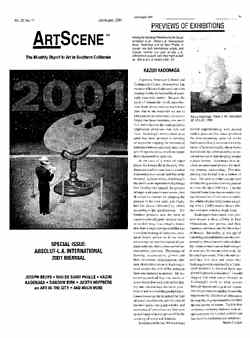| ARTSCENE KAZUO KADONAGA Previews of Exhibitions by Mario Cutajar June 10 - July 29, 2001 at Japanese American Cultural and Community Center, Downtown |
The essence of Kazuo Kadonaga's art is his making visible
the hidden life of seemingly inanimate matter. Because the cycle of human
life--birth, reproduction, death, decay--runs so much faster than that
of the materials we use to fabricate our environment, it is easy to forget
that these materials, too, are in flux and subject to the same pitilessly
impersonal processes that rule our lives. Kadonaga's entire career as an
artist has been devoted to devising strategies for trapping the moments
of transition between physical states that give things like glass, wood,
and paper their characteristic qualities.
In the case of a series of paper pieces Kadonaga did in the
early '80s, the transition from one state to another is recorded as an
actual fault line in the material. In these works, which typify the artist's
working methods, Kadonaga first familiarized himself the process of large-scale
paper manufacture, then developed a concept for adapting the process to
his own ends, and finally had the pieces fabricated by others according
to his specifications. The finished products took the form of stacked reams
of paper--some as much as six feet long--that abruptly transition from
a single compressed block to a swollen layering of numerous, separated
sheets, almost as if one were witnessing the transformation of raw paper
pulp into that quintessential human artifact, the book. The themes of layering,
accumulation, growth and their inversions (delamination, erosion, destruction)
recur in Kadonaga's work despite the shift of his attention from one material
to another. He has turned squared-off logs into stacks of wood sheets that
warp and curl as they dry out, charred logs buried in pyramids of ash to
reveal the gradual transformation along the length of the logs of wood
into charcoal, split the ends of bamboo poles into giant whisks, and orchestrated
"conversations" that were an exchange of noises given off by
the cracking of wood and bamboo.
Sometime in the late '80s Kadonaga started experimenting
with poured molten glass and has since produced the ever-expanding series
of works that is most closely associated with his name. Characteristically,
these works started with the artist spending an extended period of time
hanging around a glass factory. Kadonaga then devised an automated process
for melting, pouring, and cooling. The slow pouring can extend over a period
of days. The cooling of the viscous mass of white-hot glass has to be very
gradual and can take up to 100 days. Like the mineral formations they resemble
(stalagmites and lava flows come to mind), the solidified glass taffy (some
weighing over a 1,000 pounds) shows infinite variation within a single
form
 Kadonaga's fascination with process reveals a close affinity
to Post Minimalism, arte povera, and their Japanese version, mono-ha (the
school of things). Inevitably, in this age of vanishing cultural identity
and the compensatory obsession with cultural identity, some writers want
to find vestiges of animistic Shintoism in his work. In his catalogue essay,
Yukio Kondo demolishes this idea and notes that Kadonaga's work is marked
by a "cleareyed attention to material facts supported by precise calculation."
I would suggest that what comes through in Kadonaga's work is what comes
through process art in general: a post-industrial romanticism that reveres
the impersonality of industrial fabrication the way the original romantics
revered the raw power of nature. Tacit in that reverence for heavy industry
is an acquiescence to the limited control man has over his technological
creations.
Kadonaga's fascination with process reveals a close affinity
to Post Minimalism, arte povera, and their Japanese version, mono-ha (the
school of things). Inevitably, in this age of vanishing cultural identity
and the compensatory obsession with cultural identity, some writers want
to find vestiges of animistic Shintoism in his work. In his catalogue essay,
Yukio Kondo demolishes this idea and notes that Kadonaga's work is marked
by a "cleareyed attention to material facts supported by precise calculation."
I would suggest that what comes through in Kadonaga's work is what comes
through process art in general: a post-industrial romanticism that reveres
the impersonality of industrial fabrication the way the original romantics
revered the raw power of nature. Tacit in that reverence for heavy industry
is an acquiescence to the limited control man has over his technological
creations.